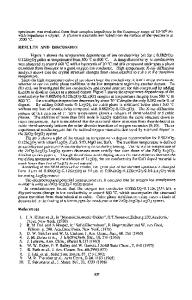Processing and Characterization of Sc 2 O 3 -CeO 2 -ZrO 2 Electrolyte Based Intermediate Temperature Solid Oxide Fuel Ce
- PDF / 3,636,636 Bytes
- 6 Pages / 612 x 792 pts (letter) Page_size
- 98 Downloads / 396 Views
0972-AA03-04
Processing and Characterization of Sc2O3-CeO2-ZrO2 Electrolyte Based Intermediate Temperature Solid Oxide Fuel Cells Alexandra Zevalkink1, Allen Hunter1, Matthew Swanson1, Christopher Johnson2, Jayanta Kapat3, and Nina Orlovskaya3 1 Michigan Technological University, Houghton, MI, 49931 2 National Energy Technology Laboratory, Morgantown, WV, 26507 3 University of Central Florida, Orlando, FL, 32816
ABSTRACT ScCeZrO2 ceramic powders produced by two different manufacturers have been used for the manufacturing of ScCeZrO2 electrolyte based Solid Oxide Fuel Cells. Thin porous anode and cathode layers have been deposited on 150 µm thick dense electrolyte layers. Preliminary electrochemical testing of the produced cells has been performed. INTRODUCTION Fully stabilized zirconia is commonly used as an electrolyte material for solid oxide fuel cells (SOFC) due to its good oxygen conductivity at high temperatures (800-1000°C). Yttria stabilized zirconia (YSZ), in particular, has been used extensively in high temperature SOFCs [1]. Although the ionic conductivity of ceramics generally increases with higher temperatures, stability, reliability, and material costs can be improved by decreasing operating temperatures. For this reason, much attention is being given to electrolyte materials that exhibit high ionic conductivity in the intermediate temperature range. One such material is Sc2O3 stabilized ZrO2 (ScSZ), which shows high conductivity in the 700-800°C range, in comparison with YSZ. The drawback of ScSZ is that it demonstrates an ordering of vacancies over time, called the aging phenomenon, accompanied by a phase transition to a lower symmetry rhombohedral phase, resulting in decreased conductivity [2]. However, when zirconia is stabilized with CeO2 as well as Sc2O3, it no longer exhibits an unfavorable phase transition, making this material a very promising option for intermediate SOFC electrolytes [3]. The goal of this research, therefore, is to develop and test Sc2O3-CeO2-ZrO2 electrolyte based single cells. EXPERIMENTAL PROCEDURE Two different commercial powders, both with the nominal composition of 10 mol% Sc2O3 + 1 mol% CeO2 + ZrO2 (ScCeZrO2), were compared for use as an intermediate temperature electrolyte material. One powder was manufactured by Praxair Surface Technologies, USA, using spray pyrolysis, and the other by Daiichi Kigenso Kagaku Kogyo Co., (DKKK), Japan, using co-precipitation technique. Although the nominal compositions of both powders were the same, inductively coupled plasma mass spectroscopy (ICP MS) has shown that the true compositions are 15% Sc2O3 + 0.05% HfO2 + 0.4% CeO2 + 2%TiO2 + ZrO2 for the Praxair powder, and 10.07% Sc2O3 + 0.92% HfO2 + 1.03% CeO2 + 1.4%TiO2 + ZrO2 for the DKKK powder [4].
For the cathode La0.6Sr0.4Fe0.8Co0.2O3 (LSFC) powder was mixed with 20 mol% Gd2O3 + CeO2 (GDC) in a 50:50 wt% ratio. Both the LSFC and GDC powders were manufactured by Praxair Surface Technologies. 35 wt% NiO powder, manufactured by Novamet, USA, and 65wt% ScCeZrO2 were mixed together
Data Loading...











